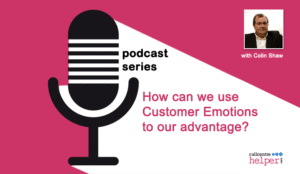Mapping emotions onto the customer journey can greatly enhance the customer experience. This article by Martin Wright explains how companies can do this effectively.
Why It Is Important to Map Emotions
Most customer experience projects focus on rational drivers of customer behaviour. Measures like price, speed, channel choice, and so on. Of course these are important, but they only tell one part of the story.
Less tangible, emotional considerations, such as first impressions and how an interaction makes a customer feel, can be even more important in determining if a customer buys or not, recommends you or not, complains or not.
We have worked with companies who focused for years on delivering speedy first call resolution, believing it to be the driver of satisfaction.
However, by exploring customer emotions we revealed that what their customers value more highly than speed is to feel confident they are getting the correct resolution to their issue.
We piloted changes that increased call duration. But by taking time to ensure customers spoke to the right expert, repeat calls and the overall cost to serve went down, and satisfaction went up.
For more great reading on customer emotions, read our article: 7 Steps to Evoke the Emotions You Want From Your Customers
The Power of the Subconscious
Research into human psychology tells us that if the conscious mind has the equivalent of 50 bits of processing power, the subconscious, emotional mind by comparison would have 11,000,000 bits (Daniel Kahneman: Thinking, Fast and Slow. Jonathan Haidt: The Happiness Hypothesis and The Righteous Mind).
The most successful brands capture how interactions make customers feel. They make sure their staff relate to customers’ experiences on an emotional level.
If your staff feel your customers’ joy and pain, they are far more likely to put in the discretionary effort needed to give customers more of what they want and less of what drives them mad.
Delight and Despair
Of course, it is important to understand customers’ highs and lows. Only then can staff properly empathize and leverage the power of the experience.
However, the truth for most organizations is that the greatest improvement comes from driving out error. And that can only come by understanding when and why things go wrong.
It can be uncomfortable listening to customers’ frustrations and anger. However, the paradox is that firms must both celebrate their considerable successes and be brutally honest about their failings.
5 Steps to Capturing Emotions
1. Start by Capturing What Your Staff Know
Front-line staff deal with emotional customers every day and they are the people who must ultimately make the bulk of any change that is required. It is vital, therefore, to start with them.
Customer Journey Mapping workshops are the best way to systematically go through a journey and explore what happens at every stage.
- What works well, and what works less well?
- What are the things that really get customers singing your praises or moaning with frustration?
However, staff insight alone is not enough. Colleagues will have anecdotal stories about customers’ emotions but can struggle to gauge how common this is, or if these emotional outbursts are a reflection of flawed customers or flawed services.
All too often these stories become the theme tune to a ‘them and us’ culture. In many organizations front-line staff feel they must go into battle with customers.
Only quantitative research can give you the unvarnished customer perspective, to clarify what actually happens, what customers expect and how any mismatch makes them feel.
2. Talk to Your Customers (In-Depth Qualitative Research)
Very few organizations routinely collect qualitative research about customers’ service experiences. However, this provides the single most powerful insight into customer emotions.
We always recommend that Customer Journey Mapping projects include in-depth research with customers who have recently experienced the target journey, including some who have had a bad experience.
Whilst focus groups can be used, we generally find 1-2-1 in-depth interviews uncover more detail and make it easier to distinguish the expectations of different types of customer.
Ensure every interview is recorded and edited highlights are produced. What surprises staff when they listen to customers is the strength of their feelings; something a low NPS or CSat score can never properly communicate.
There are other qualitative techniques you can use to add more detail or to reduce cost, such as:
Accompanied Visits
Although expensive, accompanying customers as they go through a process provides a more reliable record of customer experiences. This can be in person, via screen sharing or listening into calls.
A researcher can get a very immediate view of precisely what happens and the nuances of how people react to the situation.
Real Customer Stories
Where there is no budget for in-depth research, a low-cost alternative is to produce what we call a ‘real customer story’. This picks a single customer who has had a bad experience and documents all of their interactions to produce a timeline.
However, to bring the story to life you must be able to include call recordings and copies of written correspondence.
Whilst this only gives the story of one customer, it does:
- show how small problems escalate and how this makes customers feel
- ask the question ‘if things went so badly wrong for this customer how many others experience something similar?’
- allow you to explore what you could do differently to avoid this happening to others.
3. Review Complaints
Complaints provide a gold-mine of information, and companies who consistently deliver the best customer service invest a huge amount of effort understanding the root causes of complaints and using this to drive change.
Of course, most customers won’t complain. Those that do generally feel a line has been crossed, that their realistic expectations, and trust, has been broken.
A good complaints process allows you to link complaints to specific journeys, and listening to recordings of complaints or interviewing the customers reveals the root cause of their anger and frustration.
Read our article Top Tips for Dealing with Customer Complaints in Call Centres for expert advice on how to handle complaints
4. Quantify How Many Customers Feel That Way
Qualitative techniques will provide evidence about what triggers good and bad experiences and how different customers feel as they go through a journey.
It will also help you identify the Moments of Truth – those instances that can colour perceptions of the entire journey and undo all the great work you have done elsewhere.
Use the findings from qualitative research to help you define what questions you should ask in your quantitative surveys. Both periodic and event-driven surveys will provide robust and reliable evidence of how often these things happen – are any negative emotions an occasional blip or a regular occurrence?
How good is good enough, or how often it’s acceptable to get things wrong is the subject of much debate. The truth, however, depends very much on each type of experience; is it a moment of truth or a basic requirement (a hygiene factor), for example?
For information on how to improve your customer surveys, read our article: How to Create the Best Customer Service Survey – With Examples
5. Bring It All Together – Add Emotions to Customer Journey Maps
Customer journey maps provide a fantastic tool to pull together diverse information into a concise, action-oriented narrative.
There is no single ‘correct’ customer journey map. Your journey maps should be designed to meet your organization’s exact requirements.
However, as a rule of thumb, we will normally include at least two or three swim lanes that record different aspects of customer emotions at each stage of their journey.
These can include:
- Identifying which touchpoints are moments of truth
- Verbatim quotes from customers that illustrate positive and negative emotional responses to different interactions
- A measure of the emotional state at key touchpoints. This can be a score generated through quantitative research, such as NPS (net promoter score), or an internally generated mark out of 10, or RAG (red, amber, green)
- Scores of how often the underlying emotional need is not met, e.g. x% did not feel confident they got the correct answer to their query
- Number of complaints per 1,000 interactions and so forth.
Interpreting Customer Emotions to Drive Change
Understanding customers’ emotions better gives an organization many benefits:
- It is the key that helps unlock staff empathy; vital to gain the discretionary effort needed to make change happen.
- It provides a more accurate picture of the reputational benefit or damage experiences create.
- It informs service and product design so you can give customers more of what they truly value.
- And finally, it helps organizations prioritize resources to change or improve the parts of its offering that will have the greatest impact.
Analysing the customer emotions in your journey map allows you to define, for each key touchpoint:
- How good customers feel that experience is
- If it is a:
- Moment of truth – An interaction that has a disproportionate impact on customer perceptions. This is generally a customer’s first interaction with a brand and the moment the expected service/product benefit is delivered, or not.
- Hygiene factor – interactions customers simply expect to work seamlessly every time and are intolerant of any failure. A high downside risk.
- A core interaction or functionality – customer satisfaction is directly related to how well you deliver this touchpoint (good and poor performance are weighted evenly). Even risk/reward.
- Delightful innovation – something customers do not expect to happen and are delighted when it does. High opportunity for upside.
Given the reality of finite resources, organizations can use this analysis to prioritize efforts as follows:
- First tackle moments of truth and hygiene factors that are not performing well.
- Then ensure core interactions are adequate (matching competitors, for example).
- And then, if you still have capacity for further change, for improvement, attempt to develop delightful innovations.
In other words, don’t divert resource into delightful innovation if your MOTs and hygiene factors are not performing well, consistently.
Conclusion
People tend to assume that customers make rational choices based on quantifiable characteristics of quality such as price, speed, convenience, etc.
However, emotional responses are at least as influential and so are important to understand.
Organizations who examine customer emotions reap many benefits:
- Their staff can more readily empathize with customers, a vital prerequisite to the discretionary effort needed to make change happen.
- They gain a more accurate measure of the reputational benefit or damage experiences create.
- They can use it to inform service and product design to give customers more of what they truly value.
- And finally, it helps organizations prioritize resources, to focus on those aspects of its offering that have the greatest emotional impact.
Talking to staff, conducting qualitative and quantitative research and analysing complaints are the critical techniques to understand how customers feel about each interaction they have with your organization or your products as they try to fulfil their needs.
This diverse data set is best combined into a customer journey map, a wonderful way to pull together insight into a concise, action-oriented narrative.
With this insight you can see how good each touchpoint is, and your understanding of how that makes customers feel will allow you to evaluate how important each interaction is, and so how you should prioritize your resources.
Written by: Martin Wright, Customer Journey Consultancy
Read these articles next for more great advice on customer journey mapping:
- Customer Journey Map Examples With Expert Analysis
- Customer Journey Mapping FAQs Answered
- What Are Customer Touchpoints and How Can You Identify Them?
Author: Martin Wright
Published On: 12th Oct 2022 - Last modified: 21st Oct 2025
Read more about - Customer Service Strategy, Customer Engagement, Customer Experience (CX), Customer Journey, Customer Service, Emotion, Martin Wright, Service Strategy





















